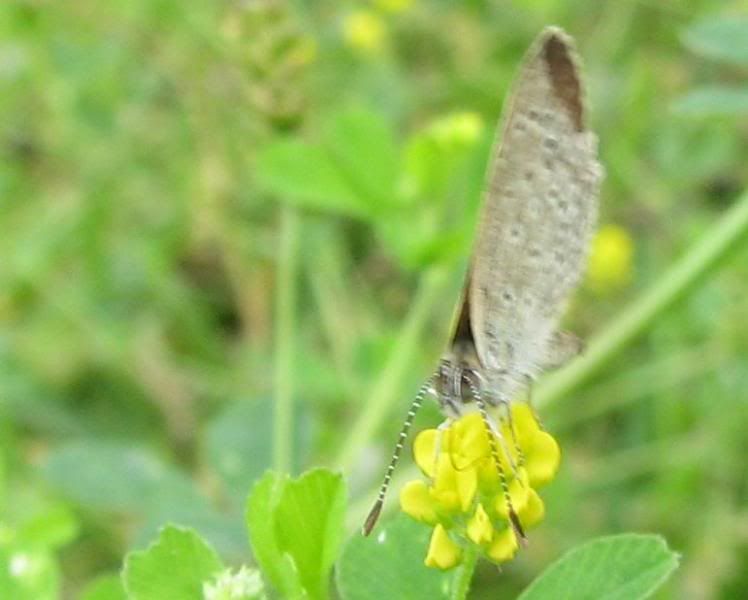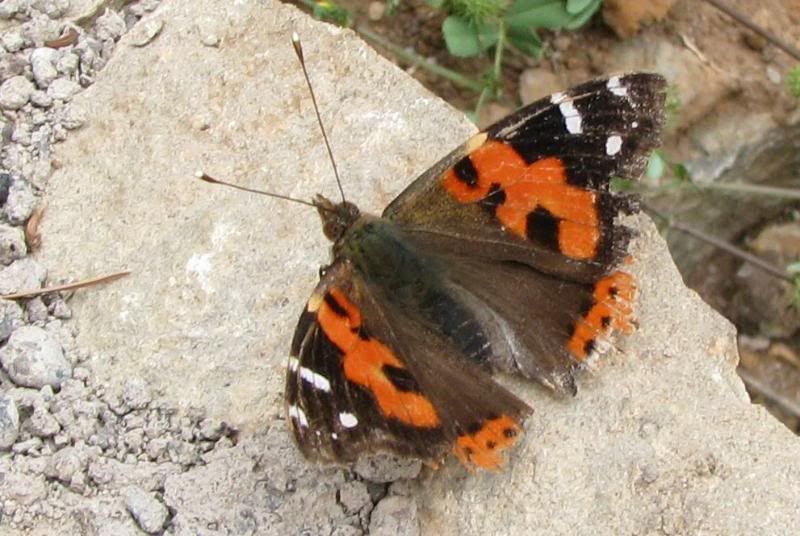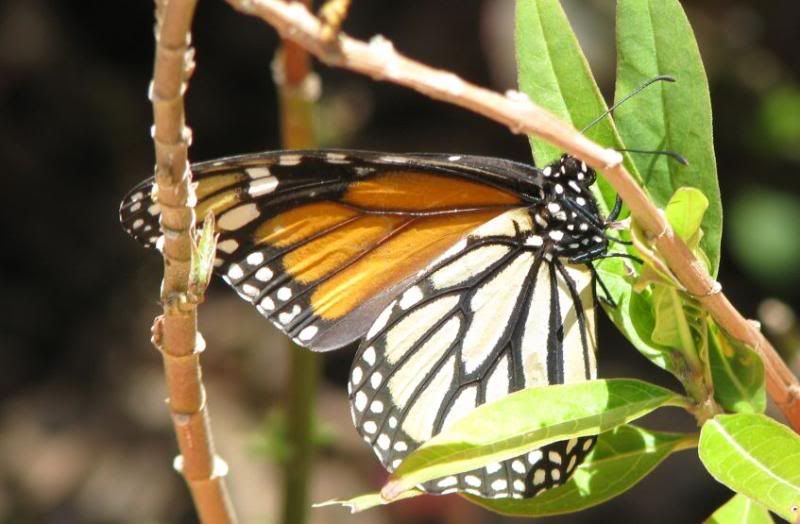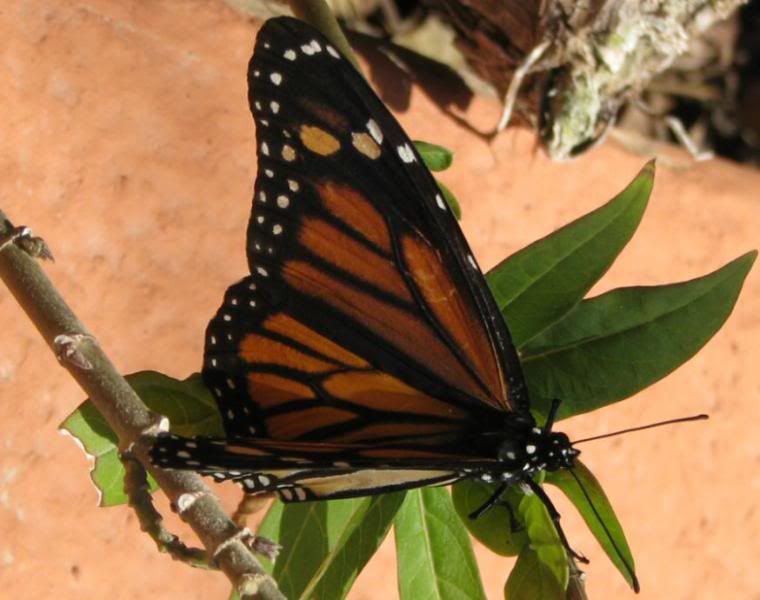Canaries
Canaries
Hi all. I'm heartily sick of winter, and looking forward to seeing some butterflies some time soon, surely? Not seen a single one so far this year, just too cold, grey and miserable. But, we're heading off to Teneriffe in May, and am eagerly anticipating lots of interesting stuff. Any one here know what we may be likely to see?
- Padfield
- Administrator

- Posts: 8182
- Joined: Sun Nov 05, 2006 10:19 pm
- Location: Leysin, Switzerland
- Contact:
Re: Canaries
Here's my log from a week in La Palma in April 2001 to whet your appetite. Tenerife has pretty much the same species.
April 4th : Flew to La Palma, arriving at airport late afternoon and at Los Llanos de Aridane at about 7.00pm. One butterfly flying across road in Santa Cruz, which I guessed was Canary Speckled Wood, but couldn't possibly tell, and plenty of whites seen from the bus. Walk at Los Llanos provided nothing except a few small whites.
5th : Brown Argus ssp crameri - in La Caldera, near Los Llanos, as well as fairly commonly along walk from Los Canarios to Charco (south western part of island). Small Copper very common in south western part. This was also the only species found higher up towards the volcanic ridge, which I walked first. Several colonies of Canary Blue along Canarios-Charco walk. This was mid-afternoon and the butterflies would not settle. Photographing them near impossible, as they fluttered around incessantly. But quite easy to identify them, looking not unlike purple hairstreaks in general appearance and with the underside markings visible at close range even in flight. Also some Long-tailed Blue at same sites, and separately, identifiable by faster flight and the fact they did occasionally settle. Canary Islands Large White occasional - not really common, but easy to spot. Also very hard to photograph, as constantly moving. The markings of the forewing are easily visible in flight. Saw two Canary Speckled Woods on this walk, both only in flight. The forests above this track are pine, which is not the Canary Speckled Wood's real habitat - it prefers laurel. Also several Bath Whites, including a mating pair, which I was able to photograph well. At one point on the track, two Queen of Spain Fritillaries sunning and gliding along the hot, sandy track. These are allegedly only migrants in the Canaries, although they looked very much at home here. Other species on 5th : Painted Lady (several); Small White (plentiful); Clouded Yellow (several).
6th : Went to Santa Cruz, on eastern side of island, to explore from there. But easterly winds created cloud and mist - even rain - so found nothing. On return to west found that it was still sunny there. But evening walk, as on 4th, produced absolutely nothing.
7th : Returned to Los Canarios and walked to Charco, whence back to Los Llanos. Mist combing over ridge from east, by same winds as yesterday, and little to see. Mostly, same species as on 5th, without Queen of Spain and with more Brown Arguses.
8th : Walked from Los Llanos, through El Paso, up to El Pino de la Virgen, whence up to ridge of Caldera and down to eastern side to Santa Cruz. On western side saw very little, though filmed Canary Islands Large White at El Pino de la Virgen. On eastern side, beautiful laurel forests reaching down, with a sunny track. More and more Canary Speckled Woods as I descended towards human habitation. Some Canary Blues, although not as frequent as on the western side. More Canary Islands Large Whites, including some males, which have the same underside marks on the forewing as the female, making them equally easy to identify (not that there is any need to identify them, as there are no other Large Whites on the island). Plenty of Small Whites, as well as Small Coppers, Brown Argus (this was the first species I saw over the ridge) and, lower down increasingly, Meadow Browns. Two Lulworth Skippers, the only skipper on the island, one of which I managed to film, but not photograph. Painted Lady.
9th : Leaving the hotel for the bus station in Los Llanos, saw single male African Grass Blue on grass verge! Did photograph and film it, but badly, as passers-by were wondering what on earth I was doing crouched down on the pavement by an obscure, dirty-looking, very small insect. Bus to Los Canarios, then down to eastern coastal regions to look for Plain Tigers. Found what appeared to be a small colony of them, with up to three at one time flying around and very, very occasionally settling on, purple flowers near farmland, above a deep coastal gully. These are beautiful, elegant, exotic and pathologically restless creatures. Also found two African Grass Blues in same region but could not photograph them. On return to Los Canarios, a single Indian Red Admiral flew past, at close range. This was to be the only Indian Red Admiral of the holiday.
10th : Walk from Los Canarios to Santa Cruz, mostly along main roads and tracks, to find out what habitats there were on the east. Many of the by now usual species flying, including also a couple of Plain Tigers. Filmed, but couldn't get close enough to photograph, a male Cleopatra, ssp. palmae, which looks quite different in flight from the more typical Cleopatras of southern Europe. The orange on the forewings is more watery, diffuse and less demarcated. Saw Canary Blues in several places and quite a few Canary Speckled Woods, especally as I approached Santa Cruz.
11th : Last day on the island. Went back to Plain Tiger habitat and found that even more flew closer to the coast, but always in a vertical line from the original ones I found. In fact, found three really good places for watching them, all in the same vertical line, where it crossed the traversing coastal path. Up to 6 Plain Tigers at once. Because this is actually quite a barren, windy, coastal area, saw very little else.
Guy
April 4th : Flew to La Palma, arriving at airport late afternoon and at Los Llanos de Aridane at about 7.00pm. One butterfly flying across road in Santa Cruz, which I guessed was Canary Speckled Wood, but couldn't possibly tell, and plenty of whites seen from the bus. Walk at Los Llanos provided nothing except a few small whites.
5th : Brown Argus ssp crameri - in La Caldera, near Los Llanos, as well as fairly commonly along walk from Los Canarios to Charco (south western part of island). Small Copper very common in south western part. This was also the only species found higher up towards the volcanic ridge, which I walked first. Several colonies of Canary Blue along Canarios-Charco walk. This was mid-afternoon and the butterflies would not settle. Photographing them near impossible, as they fluttered around incessantly. But quite easy to identify them, looking not unlike purple hairstreaks in general appearance and with the underside markings visible at close range even in flight. Also some Long-tailed Blue at same sites, and separately, identifiable by faster flight and the fact they did occasionally settle. Canary Islands Large White occasional - not really common, but easy to spot. Also very hard to photograph, as constantly moving. The markings of the forewing are easily visible in flight. Saw two Canary Speckled Woods on this walk, both only in flight. The forests above this track are pine, which is not the Canary Speckled Wood's real habitat - it prefers laurel. Also several Bath Whites, including a mating pair, which I was able to photograph well. At one point on the track, two Queen of Spain Fritillaries sunning and gliding along the hot, sandy track. These are allegedly only migrants in the Canaries, although they looked very much at home here. Other species on 5th : Painted Lady (several); Small White (plentiful); Clouded Yellow (several).
6th : Went to Santa Cruz, on eastern side of island, to explore from there. But easterly winds created cloud and mist - even rain - so found nothing. On return to west found that it was still sunny there. But evening walk, as on 4th, produced absolutely nothing.
7th : Returned to Los Canarios and walked to Charco, whence back to Los Llanos. Mist combing over ridge from east, by same winds as yesterday, and little to see. Mostly, same species as on 5th, without Queen of Spain and with more Brown Arguses.
8th : Walked from Los Llanos, through El Paso, up to El Pino de la Virgen, whence up to ridge of Caldera and down to eastern side to Santa Cruz. On western side saw very little, though filmed Canary Islands Large White at El Pino de la Virgen. On eastern side, beautiful laurel forests reaching down, with a sunny track. More and more Canary Speckled Woods as I descended towards human habitation. Some Canary Blues, although not as frequent as on the western side. More Canary Islands Large Whites, including some males, which have the same underside marks on the forewing as the female, making them equally easy to identify (not that there is any need to identify them, as there are no other Large Whites on the island). Plenty of Small Whites, as well as Small Coppers, Brown Argus (this was the first species I saw over the ridge) and, lower down increasingly, Meadow Browns. Two Lulworth Skippers, the only skipper on the island, one of which I managed to film, but not photograph. Painted Lady.
9th : Leaving the hotel for the bus station in Los Llanos, saw single male African Grass Blue on grass verge! Did photograph and film it, but badly, as passers-by were wondering what on earth I was doing crouched down on the pavement by an obscure, dirty-looking, very small insect. Bus to Los Canarios, then down to eastern coastal regions to look for Plain Tigers. Found what appeared to be a small colony of them, with up to three at one time flying around and very, very occasionally settling on, purple flowers near farmland, above a deep coastal gully. These are beautiful, elegant, exotic and pathologically restless creatures. Also found two African Grass Blues in same region but could not photograph them. On return to Los Canarios, a single Indian Red Admiral flew past, at close range. This was to be the only Indian Red Admiral of the holiday.
10th : Walk from Los Canarios to Santa Cruz, mostly along main roads and tracks, to find out what habitats there were on the east. Many of the by now usual species flying, including also a couple of Plain Tigers. Filmed, but couldn't get close enough to photograph, a male Cleopatra, ssp. palmae, which looks quite different in flight from the more typical Cleopatras of southern Europe. The orange on the forewings is more watery, diffuse and less demarcated. Saw Canary Blues in several places and quite a few Canary Speckled Woods, especally as I approached Santa Cruz.
11th : Last day on the island. Went back to Plain Tiger habitat and found that even more flew closer to the coast, but always in a vertical line from the original ones I found. In fact, found three really good places for watching them, all in the same vertical line, where it crossed the traversing coastal path. Up to 6 Plain Tigers at once. Because this is actually quite a barren, windy, coastal area, saw very little else.
Guy
Guy's Butterflies: https://www.guypadfield.com
The Butterflies of Villars-Gryon : https://www.guypadfield.com/villarsgryonbook.html
The Butterflies of Villars-Gryon : https://www.guypadfield.com/villarsgryonbook.html
Re: Canaries
Hi,
We spent Xmas 2006 in Gran Canaria and we saw several Indian Red Admirals and 1 Monarch in a week. We were staying in the mountains at about 700m, this may explain why we did not see many butterflies around.
In May, there will be a lot more butterflies around. Let us know what you saw once you've been. Reports like Guy's are always a very interesting and pleasant read.
Sylvie
We spent Xmas 2006 in Gran Canaria and we saw several Indian Red Admirals and 1 Monarch in a week. We were staying in the mountains at about 700m, this may explain why we did not see many butterflies around.
In May, there will be a lot more butterflies around. Let us know what you saw once you've been. Reports like Guy's are always a very interesting and pleasant read.
Sylvie
Re: Canaries
WOW!! Thanks for all that, I'm well impressed! Looks like there'll be plenty to see. Will endevour to report when we get back, but don't think I'll be able to match the above- my identification skills not great once I'm outside the UK!!
- Padfield
- Administrator

- Posts: 8182
- Joined: Sun Nov 05, 2006 10:19 pm
- Location: Leysin, Switzerland
- Contact:
Re: Canaries
Put in the footwork! I don't drive, so I spend all day walking when I butterfly-watch and that means I find all the little colonies between obvious places that most people just zoom past.
Explore different habitats. There are probably few species in the barren volcanic bowls but plenty in the forest regions, in the little agricultural hamlets and in the coastal regions. There are actually rather few species altogether in the Canaries but many of them are endemic and others have great local forms. I envy you!!
Guy
Explore different habitats. There are probably few species in the barren volcanic bowls but plenty in the forest regions, in the little agricultural hamlets and in the coastal regions. There are actually rather few species altogether in the Canaries but many of them are endemic and others have great local forms. I envy you!!
Guy
Guy's Butterflies: https://www.guypadfield.com
The Butterflies of Villars-Gryon : https://www.guypadfield.com/villarsgryonbook.html
The Butterflies of Villars-Gryon : https://www.guypadfield.com/villarsgryonbook.html
Re: Canaries
Ok, we're back from our week in Tenerife, and sadly I have to report that we saw very few butterflies- or any other insects for that matter! I remember family holidays in Spain in the '70s when there were butterflies everywhere, plus grasshoppers with blue and red underwings, praying mantis' and all sorts of other interesting stuff. We returned to the same town last year, and there was almost nothing! I wonder if the use of pesticides to control mosquitos may be hitting other insects too? Anyway, as for Tenerife, despite lots of flowers, and walking in search of butterflies, there was disapointingly little to photograph. We saw quite a lot of whites, but other than that, there were a lot of VERY tiny blues which proved frustratingly hard to photograph:


this rather battered butterfly spotted at a cafe half way up Mt Teide:

and finally this- lots of them around the Jungle Park attraction, but settling only infrequently. Is it a Monarch, or something that looks like one?




this rather battered butterfly spotted at a cafe half way up Mt Teide:

and finally this- lots of them around the Jungle Park attraction, but settling only infrequently. Is it a Monarch, or something that looks like one?


- Padfield
- Administrator

- Posts: 8182
- Joined: Sun Nov 05, 2006 10:19 pm
- Location: Leysin, Switzerland
- Contact:
Re: Canaries
Well done! You got three of the most important things there!!
The blues were African grass blues, Zizeeria knysna, which are not endemic to the Canaries (they also occur in Spain) but that is certainly a good place to go and see them. The next species is Canary red admiral, Vanessa vulcania (the butterfly formerly known as Indian red admiral, Vanessa indica) and the last is indeed monarch, Danaus plexippus.
The thing about islands like Tenerife (or Great Britain!!) is that they have a small number of species but usually plenty of interesting endemic things (in the case of Britain, endemic subspecies).
Those are nice butterflies to see!! I spent a week on La Palma and failed to get a single picture of vulcania...
Guy
The blues were African grass blues, Zizeeria knysna, which are not endemic to the Canaries (they also occur in Spain) but that is certainly a good place to go and see them. The next species is Canary red admiral, Vanessa vulcania (the butterfly formerly known as Indian red admiral, Vanessa indica) and the last is indeed monarch, Danaus plexippus.
The thing about islands like Tenerife (or Great Britain!!) is that they have a small number of species but usually plenty of interesting endemic things (in the case of Britain, endemic subspecies).
Those are nice butterflies to see!! I spent a week on La Palma and failed to get a single picture of vulcania...
Guy
Guy's Butterflies: https://www.guypadfield.com
The Butterflies of Villars-Gryon : https://www.guypadfield.com/villarsgryonbook.html
The Butterflies of Villars-Gryon : https://www.guypadfield.com/villarsgryonbook.html
Re: Canaries
Thanks for that Padfield, I feel better now!! There were lots of those Monarchs flying round the park, so I guess they're quite common. I'd heard there was a colony in The Canaries- presumably descendants of specimans which had been blown across the Atlantic? How do they survive there- how come they are able to suppress the instinct to migrate?
